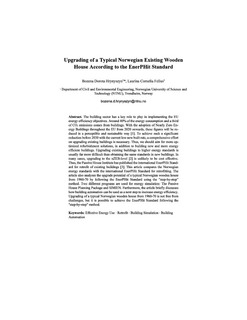Upgrading of a Typical Norwegian Existing Wooden House According to the EnerPHit Standard
Chapter
Accepted version

Åpne
Permanent lenke
http://hdl.handle.net/11250/2633508Utgivelsesdato
2019Metadata
Vis full innførselSamlinger
Originalversjon
10.1007/978-3-030-00662-4_16Sammendrag
The building sector has a key role to play in implementing the EU energy efficiency objectives. Around 40% of the energy consumption and a third of CO2 emissions comes from buildings. With the adoption of Nearly Zero Energy Buildings throughout the EU from 2020 onwards, these figures will be reduced in a perceptible and sustainable way [1]. To achieve such a significant reduction before 2030 with the current low new built rate, a comprehensive effort on upgrading existing buildings is necessary. Thus, we should aim for more optimized refurbishment solutions, in addition to building new and more energy efficient buildings. Upgrading existing buildings to higher energy standards is usually far more difficult than obtaining the same standards in new buildings. In many cases, upgrading to the nZEB-level [2] is unlikely to be cost effective. Thus, the Passive House Institute has published the international EnerPHit Standard for retrofit of existing buildings [3]. This article compares the Norwegian energy standards with the international EnerPHit Standard for retrofitting. The article also analyses the upgrade potential of a typical Norwegian wooden house from 1960 to 70 by following the EnerPHit Standard using the “step-by-step” method. Two different programs are used for energy simulation: The Passive House Planning Package and SIMIEN. Furthermore, the article briefly discusses how building automation can be used as a next step to increase energy efficiency. Upgrading of a typical Norwegian wooden house from 1960 to 70 is not free from challenges, but it is possible to achieve the EnerPHit Standard following the “step-by-step” method.